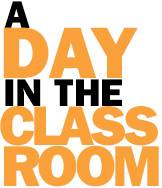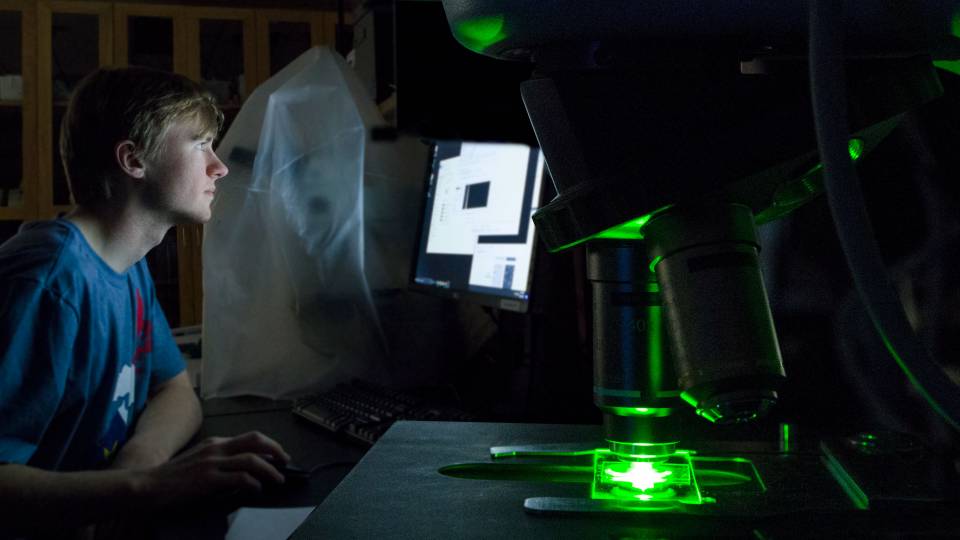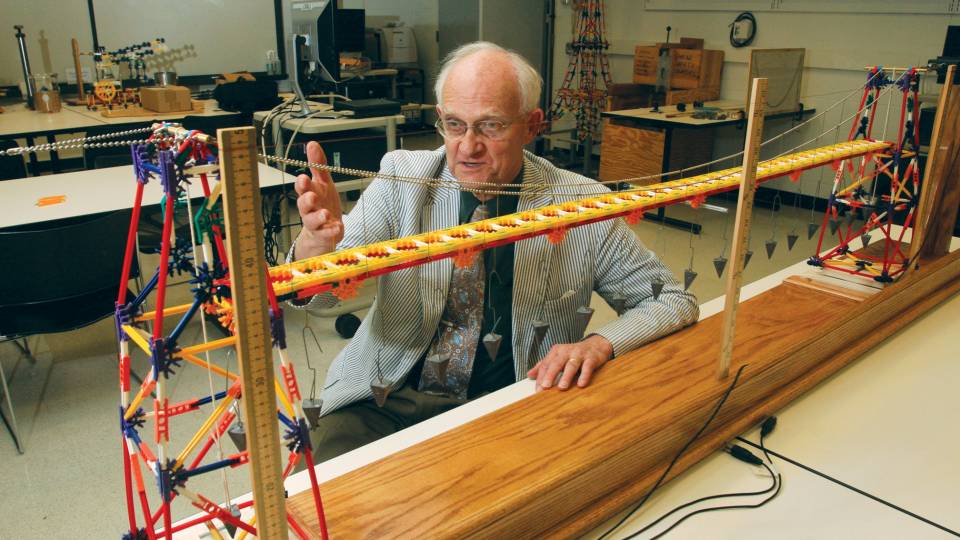This semester, Princeton University is offering more than 1,400 classes in a variety of subjects and formats.
On Monday, April 21, we visited 15 undergraduate classes across campus, spanning the humanities, natural sciences, social sciences and engineering. Below, we offer a snapshot of each class that we attended — from intimate language courses to engineering laboratory sessions involving computer-controlled vehicles.
Our schedule (click on the course title to skip to that block below):
- 10 a.m.
"Structures and the Urban Environment"
"Human Evolution" - 11 a.m.
"The Psychology of Decision Making and Judgment"
"Neuroscience and Everyday Life"
"Music and European Jewry" - 12:30 p.m.
"Intermediate Portuguese" - 1:30 p.m.
"America Then and Now"
"Graphic Design: Typography"
"An Integrated, Quantitative Introduction to the Natural Sciences II" lab - 2:30 p.m.
"Dilemmas of Development in Asia" - 3 p.m.
"Race and Medicine"
"Building Real Systems" lab
"Spenser" - 3:30 p.m.
"An Introduction to Engineering" - 7:30 p.m.
"Acting and Directing in Musical Theater"
Time: 10 a.m.
Class: "Structures and the Urban Environment"
Instructor: Maria Garlock, associate professor of civil and environmental engineering
The graceful white curves of Mexico City's Church of Our Lady of the Miraculous Medal flashed on the screen in the Guyot Hall auditorium, and, with a few brief descriptions, Professor Maria Garlock led students through the plan of the iconic building.
The church is a folded shell, its design so subtle that the concrete walls seem to billow like canvas. It is a classic example of a thin-shell structure built by Félix Candela, an engineer whose creations were so light and flowing that they often seemed to transcend their material components.
"I had studied Candela for three years before I ever visited one of his structures," Garlock said as she moved through photos of the church's gothic interior. "I was totally unprepared for the sense of height when I walked into this space."
Candela brought an artistic vision to projects such as Mexico's Bacardí rum factory and Cosmic Rays research station. Garlock said Candela's engineering skill, which was disciplined by efficiency and economy, allowed him to create designs in which elegance is matched with an underlying resilience.
"The form is right," she said. "Mexico City had a huge earthquake in 1985, and all of Candela's structures survived — every one."
—By John Sullivan
Time: 10 a.m.
Class: "Human Evolution"
Instructors: Alan Mann, professor of anthropology; Janet Monge, visiting professor of anthropology
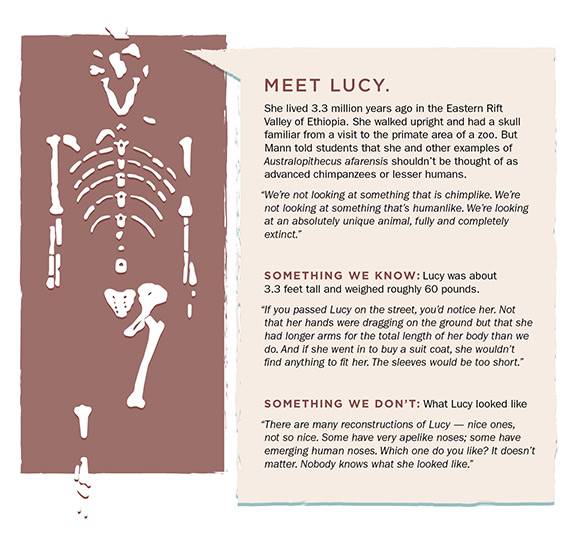
This illustration is derived from Alan Mann's lecture on Lucy, a member of the early human species Australopithecus afarensis, whose skeleton was found in Ethiopia in 1974. (Illustration by Michael Hotchkiss and Kyle McKernan)
Time: 11 a.m.
Class: "The Psychology of Decision Making and Judgment"
Instructor: Eldar Shafir, the William Stewart Tod Professor of Psychology and Public Affairs
Emotional responses, or affect, play an important role in decision making, yet "mood has its own logic," Professor Eldar Shafir said as he introduced a new approach to understanding human behavior.
For instance, mood can be influenced in counter-intuitive ways by events. One study showed that when Olympic winners were photographed, bronze medalists appeared to be much happier than the silver medalists, because the silver medal winners were likely focused on having failed to achieve the gold medal. Meanwhile the bronze medalists were ecstatic to have gotten a medal at all.
Studies have also shown how emotions such as compassion override logic in how people respond to marketing materials for charitable giving. People donate more when presented with one or two identifiable people in need, rather than a barrage of stories or statistics about millions of people, Shafir said, showing a Save the Children appeal.
"That story of this girl with her picture causes an affective response that is largely missing … by the academic speaking of millions," Shafir said. This response has applications for how academic experts and policymakers can advocate effectively for action.
Afterward, junior Dalia Katan said the class offered a good psychological perspective to decision making, "whether you are into policymaking or advertising. The class is one of the more practical courses at Princeton."
—By Elizabeth Patten
Time: 11 a.m.
Class: "Neuroscience and Everyday Life"
Instructors: Alan Gelperin, senior lecturer in molecular biology and the Princeton Neuroscience Institute; Samuel Wang, associate professor of molecular biology and the Princeton Neuroscience Institute
The lights dimmed and Professor Samuel Wang, neuroscientist and co-author of the popular books "Welcome to Your Brain" and "Welcome to Your Child's Brain," was ready to teach what it means for a brain to get old. "These are the normal aging mechanisms that will happen to everybody," he said, opening up a slide show, "including you."
The first slide showed a graph representing memory, with lines heading south after "peaking at about age 30," Wang said. A series of jagged lines on another slide illustrated how brains get smaller as they age. Flat lines on the next graph showed what happens when autumn comes to the tree-like structures of the neural dendrites. Then there were slides of abnormal brain degeneration — Alzheimer's, Parkinson's and what Wang called stroke's terrible "insult" to the cerebral cortex.
"But some aspects of brain function can improve over time," said Wang. Vocabulary tends to increase. Negative emotions tend to decrease. And skills you learn thoroughly in your youth and practice throughout your life are stored in a "cognitive reserve" that is often spared.
"Is anything protective?" asked one student.
"Physical excercise," said Wang, who has studied brain training and sees its effects as limited. "Sweat, not Sudoku."
—By Jill Feldman
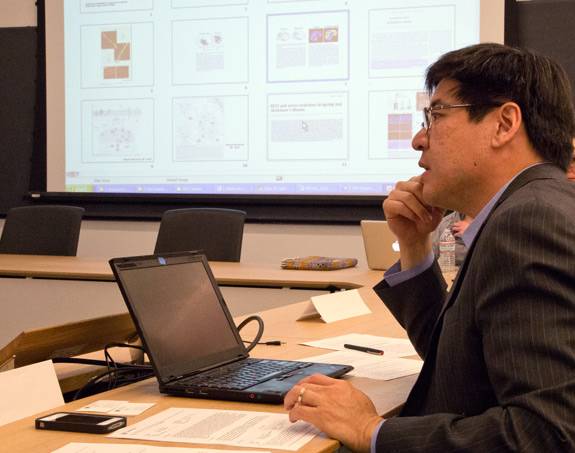
Professor Samuel Wang leads a class discussion on features of neurological aging that happen to everybody, "including you." (Photo by Danielle Alio)
Time: 11 a.m.
Class: "Music and European Jewry"
Instructor: Wendy Heller, professor of music
Seated among a circle of desks, students each read a part from the popular 1880 Yiddish play "The Two Kuni-Lemls" by Avrom Goldfaden. In the complex plot, a Hassidic woman wants to break tradition by marrying her educated tutor rather than the groom a matchmaker has selected — a bumbling man named Kuni-Leml. The tutor pretends to be Kuni-Leml and a comedy of errors ensues.
The play is interspersed with songs, and Professor Wendy Heller explained that while the lyrics are retained in the text, scholars only have some sense how the original music sounded. "The only surviving piece of sheet music is one violin part," Heller said.
But students were able to get a sense of the music — junior Stephanie Liu enlivened the class by playing violin throughout the reading.
In one song, the young woman sings about being "raised in a gloomy tower," but having her "soul revived" when she started to eat from the tree of knowledge.
"It's interesting how every stanza is sort of broken in half, where you have a dark section and then you have a lighter section," senior Michael Moses said. "The sadder parts are juxtaposed with happier parts."
Heller noted how the song reflects the tensions within Judaism in 19th-century Eastern Europe. "In the culture we've been discussing, there is a real sense of are you going to remain separate or are you going to join the world — assimilate," she said. "This piece really lays it right out there in interesting ways."
—By Emily Aronson
Time: 12:30 p.m.
Class: "Intermediate Portuguese"
Instructor: Megwen Loveless, lecturer in Spanish and Portuguese languages and cultures
High school memories of flash cards and conjugation quizzes in other languages fade away for students gathered in this high-energy class that immerses them in Portuguese conversation.
"The cool thing about Portuguese classes here is that they focus on communication," said sophomore Jean-Carlos Arenas. "You don't get away with speaking English," noted sophomore Tomi Johnson.
On Monday, Lecturer Megwen Loveless allowed the fun to flow in this class to teach Portuguese to Spanish speakers. She adapted the board game Taboo to build vocabulary based on the students' reading assignment. Each student drew a card and — while not saying any of its "taboo" synonyms — tried to get others to guess the word on the card. The students erupted in laughter and pumped their arms when they got the answers right. Taking turns, the students squeezed a rubber chicken as a buzzer — "buzina de frango" — whenever a player ran afoul of the rules.
"I love for students to enjoy learning," Loveless said. She balances serious study in the class — students are reading a novel in Portuguese — with the games to aid the learning. While playing, "You stop being so self-concious about your language choice."
—By Daniel Day
Time: 1:30 p.m.
Class: "America Then and Now"
Instructors: Rachael DeLue, associate professor of art and archaeology; Paul Frymer, associate professor of politics; Imani Perry, professor of African American studies
With the last few weeks of the semester focused on community in America, Professor Imani Perry, who co-teaches the class with two professors, framed the discussion by referring to scholar Benedict Anderson's book "Imagined Communities."
"We develop a sense of a collective self, an us, as members of the nation through shared symbols," Perry said. "One of the symbols of this collective self that Anderson talks about is anthems."
Anthems evoke a simultaneous, emotional response, Perry said. Some examples, presented by playing audio and showing YouTube videos, included:
- The U.S. national anthem, "The Star-Spangled Banner," written by American Francis Scott Key, and set to music by an English composer;
- "Lift Every Voice and Sing" by James Weldon Johnson, known as the African American national anthem and set to a march style based in European culture;
- New York City anthems, from Frank Sinatra's version of "New York, New York" to Jay Z and Alicia Keys' "Empire State of Mind"; and
- "Sweet Home Alabama," by the rock group Lynyrd Skynyrd, which was a response to an attack on racial attitudes in the state and later morphed into a general celebration of the state.
Despite music's muddled origins and shifting meaning, people use it to identify themselves with their imagined community. Said Perry, "I think that that's a useful lesson to think about multiplicity and diversity — of ideologies, of peoples, of aesthetics of values, of styles — and yet how we might still understand ourselves as belonging to a single people."
—By Ushma Patel
Time: 1:30 p.m.
Class: "Graphic Design: Typography"
Instructor: David Reinfurt, lecturer in visual arts and the Lewis Center for the Arts

Professor David Reinfurt (right) takes his class on a walk around Nassau Hall to examine the typography of the class stones. The students discussed the influence of tools, location and period styles on the selection of typeface and settings. Many of the students taking this course are being introduced to the study and practice of graphic design for the first time. Reinfurt is focused on teaching them "to set a text so that the form it is given works together with the substance of the text to produce a third meaning." (Photos by Micole Sharlin)
Time: 1:30 p.m.
Class: "An Integrated, Quantitative Introduction to the Natural Sciences II" lab session
Instructors: Joshua Shaevitz, associate professor of phyics and the Lewis-Sigler Institute for Integrative Genomics; Stanislav Shvartsman, professor of chemical and biological engineering and the Lewis-Sigler Institute for Integrative Genomics; Olga Troyanskaya, professor of computer science and the Lewis-Sigler Institute for Integrative Genomics; Eric Wieschaus, the Squibb Professor in Molecular Biology and professor of molecular biology and the Lewis-Sigler Institute of Integrative Genomics; Haw Yang, associate professor of chemistry
Armed with fluorescent dyes, an electrolyte solution, micropipettors and fly embryos, Monday afternoon found freshmen Minseung Choi and David Mazumder hard at work in Lewis Thomas Lab.
As the capstone of the lab portion of the yearlong class, students design and conduct their own experiments, which gives them the opportunity to apply the year's classwork and lab experience.
Jennifer Gadd, undergraduate laboratory manager and lecturer in molecular biology, noted the course provides a multidisciplinary approach to science, including aspects from chemistry, physics, biology and computer science for data analysis. "It takes concepts across several different disciplines and combines them together to answer the questions students have," she said.
Choi and Mazumder, who are among eight students in the class, are staining fly embryos and comparing the size of the DNA across different species and between cells of the same species. "It's kind of testing a rough and dirty method of estimating the species' genome size," Mazumder explained.
"We give them everything, and we just say go for it," said Gadd, noting the unusual freedom these freshmen have to pursue an independent project. "See what you can see."
—By Michael Caddell
Time: 2:30 p.m.
Class: "Dilemmas of Development in Asia"
Instructors: David Leheny, the Henry Wendt III '55 Professor of East Asian Studies; Jin Sato, visiting research scholar in East Asian studies, visiting associate professor of East Asian studies
The screen above the students lit up with the topic of the day: "Planning for the Worst."
Co-taught by Professors David Leheny and Jin Sato, the class is the first to come out of the strategic partnership established in early 2013 between Princeton and the University of Tokyo. It examines some of the challenges the countries of East Asia and Southeast Asia face as they develop.
Leheny picked up on a recent theme about responses to the catastrophic tsunami in the Indian Ocean in 2004.
"Disaster planning is taken as granted for what you do to solve disasters," Leheny said.
"Reality tends to be more complicated than the actual simulation," Leheny said about attempts to plan for catastrophes by imagining scenarios wrought by, for example, earthquakes, hurricanes and disease. He described how ideas of risk and insurance have affected planning for emergencies, as well as how culture can play a significant role.
Leheny also spoke of the approach to and effects of development aid after a disaster. He highlighted how Japan played a major role in responding to the 2004 tsunami, while grappling with a host of questions about how it should act. "Developmental rhetoric shapes how aid is given," he said.
—By Karin Dienst
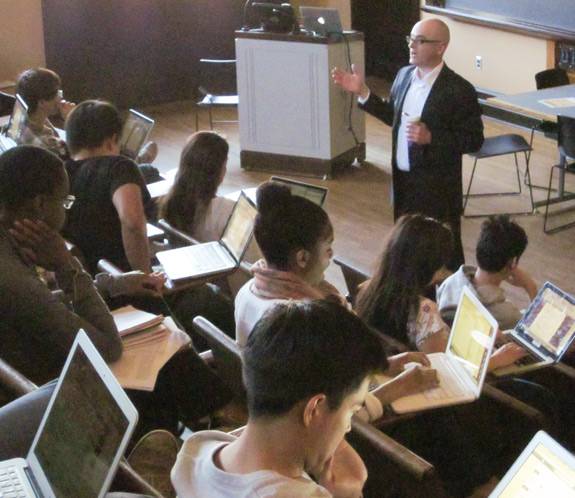
East Asian studies professor David Leheny discusses disaster planning and development aid in the class "Dilemmas of Development in Asia." Leheny is co-teaching the course with Jin Sato, a visiting scholar from the University of Tokyo. (Photo by Laurel Masten Cantor)
Time: 3 p.m.
Class: "Race and Medicine"
Instructor: Carolyn Rouse, professor of anthropology
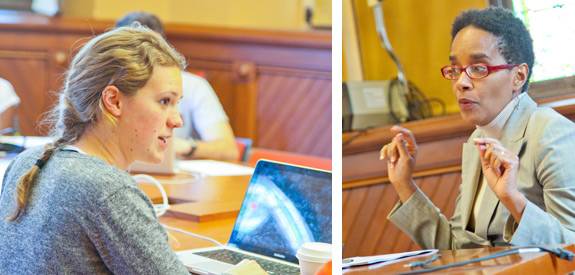
Professor Carolyn Rouse (right) and her students, such as junior Sarah Morgan (left), discuss the topic of the week, "What is social justice in medicine?" In health policy, Rouse said, social justice translates to what we believe citizens are owed in terms of health information, services and choices. Anthropological approaches — understanding the wide range of factors influencing people's beliefs and behaviors, not just numerical data — allows for tailored approaches to issues, from higher-than-average mortality rates of breast cancer in African American women, to lower-than-average life expectancy for white men in West Virginia. The amount of knowledge each person has, Rouse said, affects whether "we'll make the right choices." (Photos by Nick Barberio)
Time: 3 p.m.
Class: "Building Real Systems" lab session
Instructors: Andrew Houck, associate professor of electrical engineering; Antoine Kahn, professor of electrical engineering
Samantha Lee and Gisela Murroni thought about hurricanes when they planned their project for "Building Real Systems."
The course, known informally as "Car Lab," is a junior-year rite of passage for electrical engineering majors. Like a microcosm of the undergraduate experience at Princeton, the course starts with structured assignments — students build computer-controlled cars that maintain a steady speed and track a path taped to the floor — then progresses to independent work on a task they define themselves.
Lee and Murroni, who are both from Florida, imagined a vehicle that could automatically clean up storm wreckage, distinguishing, for example, metal in a roadway from a tree branch. "We were trying to think of something that had a lot of real-world applications," Lee said.
On April 21, their task came down to fitting the car with a circuit that would simply allow it to reverse direction. Later, they planned to install color cameras that would distinguish a series of color-coded weights from each other, allowing the car to find them in a room and sort them to assigned locations.
Professor Antoine Kahn, who co-teaches with Associate Professor Andrew Houck, five graduate students and six senior undergraduates, said the course is the capstone of the theoretical information juniors have absorbed since their sophomore years, adding, "This is the first time they really design something and make it work."
—By Steven Schultz
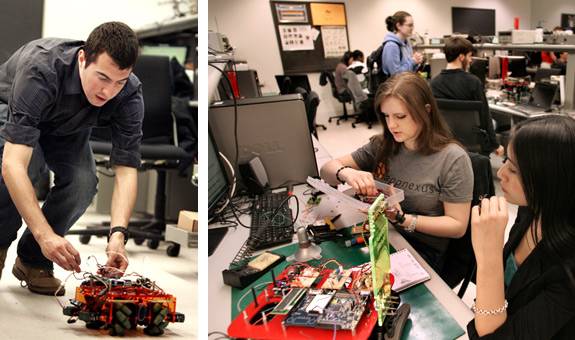
Junior Adam Yabroudi makes adjustments to his team's computer-controlled vehicle while it is in motion as part of an afternoon's work in the electrical engineering course "Building Real Systems." Juniors Samantha Lee (left) and Gisela Murroni (right) work on their vehicle, which they are designing to pick up and sort color-coded weights. They were inspired by the idea of an autonomous vehicle that could clean up streets after storms. (Photos by Frank Wojciechowski)
Time: 3 p.m.
Class: "Spenser"
Instructor: Jeff Dolven, associate professor of English
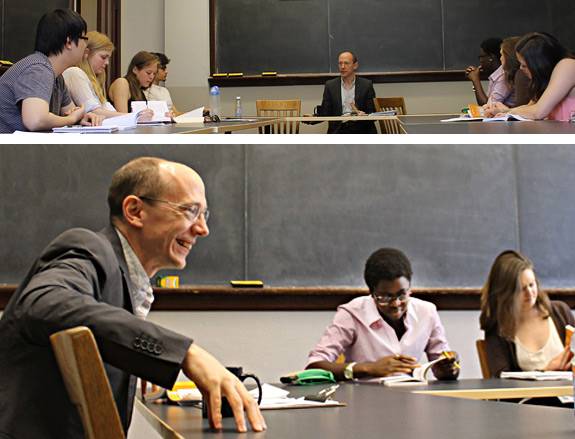
Professor Jeff Dolven and his small seminar class discuss the idea of "Courtesie," the central Elizabethan value in Book VI of Edmund Spenser's "The Faerie Queene." Parsing the idea of courtesy, the students debated whether courtesy was only manifested through speech and not actions, and whether courtesy was a virtue, as it had no inherent moral compass. The class analyzed these ideas through close readings; volunteering personal examples, "like when your mother asks you to be courteous at a party you didn't want to attend," one student said; and recalling pop culture, such as the film "Philadephia Story," in which words don't win the girl at the end. (Photos by Matilda Luk)
Time: 3:30 p.m.
Class: "An Introduction to Engineering"
Instructors: Jay Benziger, professor of chemical and biological engineering; Michael Littman, professor of mechanical and aerospace engineering; Stephen Lyon, professor of electrical engineering; Peter Ramadge, the Gordon Y.S. Wu Professor of Engineering and professor of electrical engineering
Professor Michael Littman turned from the small electric motors carefully staged on a display table in his Friend Center classroom and asked his engineering students about their progress in introductory physics.
"It is toward the end of the semester, so you are all experts on electricity and magnetism," Littman said, pausing for a response, which was some nervous laughter. "That is an interesting laugh. Well, you will be when finals come around."
Over the next hour, Littman showed the students how to measure torque and calculate power and efficiency in an electric motor. He even gave a brief history lesson using a replica of the first "electro-magnetic engine," built in 1831 by scientist Joseph Henry, who later taught at Princeton.
"Is that pretty cool?" Littman asked the class, stepping back with a wide grin as the small motor drove a lever back and forth. "I really think it is."
—By John Sullivan

In the class "An Introduction to Engineering," Professor Michael Littman uses electric motors to teach a unit on electricity and magnetism. (Photo by Frank Wojciechowski)
Time: 7:30 p.m.
Class: "Acting and Directing in Musical Theater"
Instructors: Ethan Heard, lecturer in theater and the Lewis Center for the Arts; John Rando, lecturer in theater and the Lewis Center for the Arts
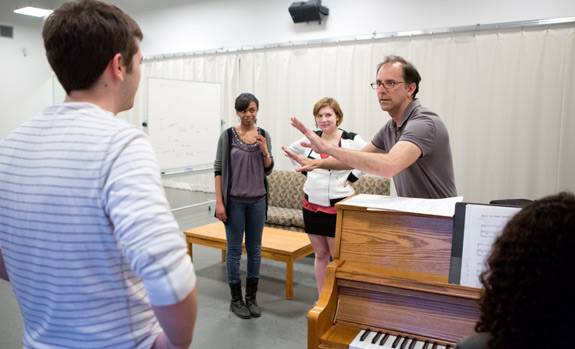
Theater people are night people. So it makes sense that "Acting and Directing in Musical Theater" meets from 7:30 to 10:20 p.m. In a bare studio with only chairs and tables for props, Lecturer Ethan Heard and guest artist director John Rando — currently directing "The Heir Apparent" in New York — create a real-life rehearsal environment, replete with an accompanist on upright piano. "We introduce and examine musical theater through performance," Rando said. "We break down scenes and songs from musicals, and work on them in a workshop situation." Above, Rando (right) gives feedback to sophomore Matt Volpe (left), as he directs juniors Erin Purdie (second from left) and Samantha Kaseta in the number "What You Don't Know About Women" from "City of Angels." (Reporting by Jamie Saxon; Photo by Denise Applewhite)
To search a database of all classes offered this semester, visit the Course Offerings section of the Registrar's site.
These classes span Princeton's academic departments and undergraduate interdepartmental programs, as well as interdisciplinary programs.
